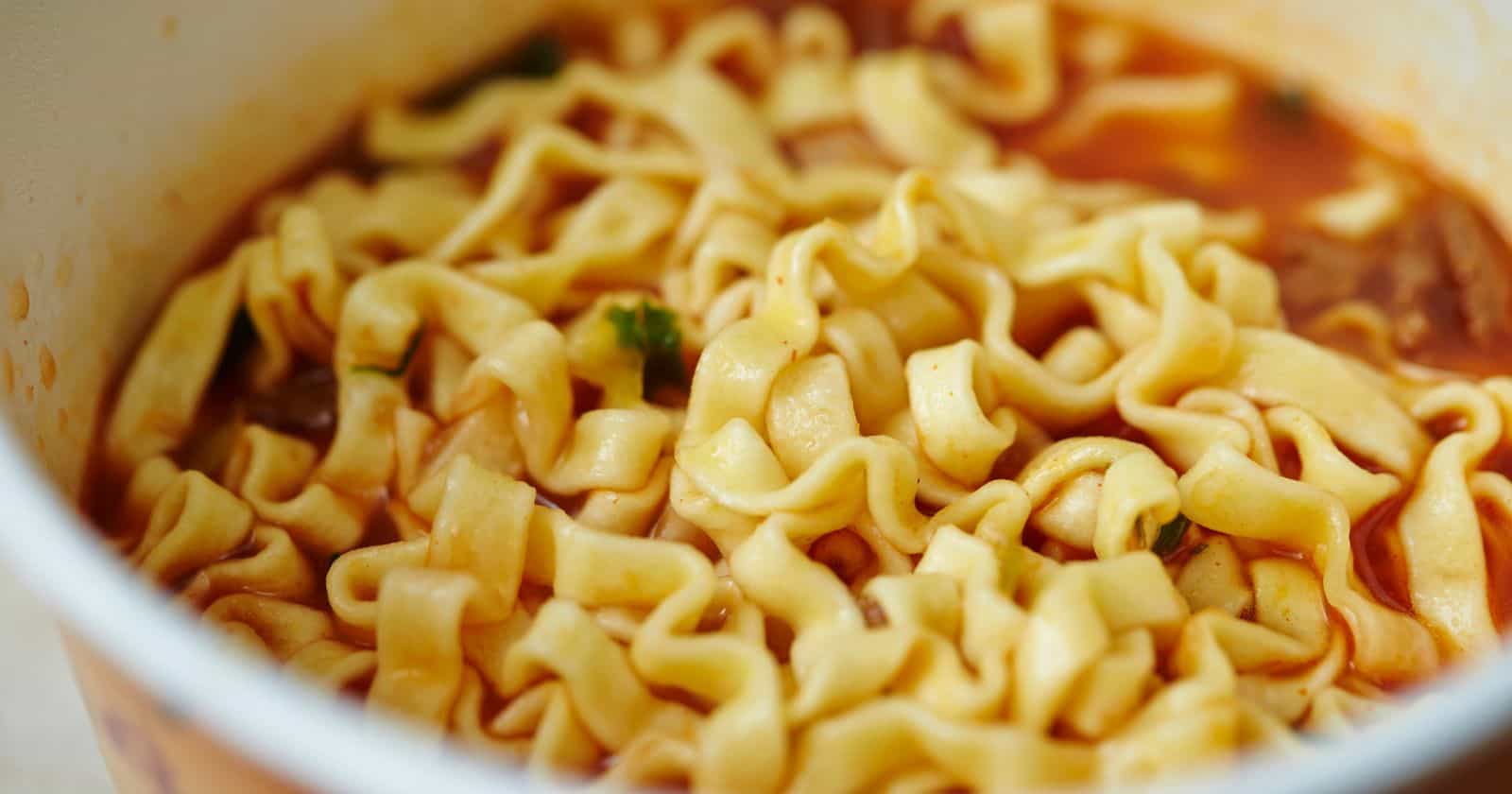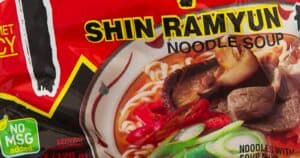Have you ever taken a bite of ramen noodles and been met with a weird chemical taste? That subtle plastic flavor can turn a delicious meal into a cringe-worthy experience. If you’ve encountered off-putting plastic tones in your noodles, you’re not alone.
But do ramen noodles actually contain plastic? Or does the taste come from elsewhere?
The good news is that ramen noodles themselves likely don’t contain plastic ingredients. The plasticky taste more often stems from packaging materials, expired noodles, or cooking mistakes.
In this article, we’ll uncover the truth about plastic flavors in ramen. You’ll learn how to identify the root causes and prevent them through proper storage, cooking techniques, and high-quality ingredients. Read on to rediscover the joy of slurping savory, flavorful noodle soup without any plastic aftertaste.
Could Packaging and Storage Materials Cause the Plastic Taste?
One common theory is that packaging or storage containers can transmit plastic flavors to ramen noodles. Chemicals may leach out of plastic materials and absorb into the noodles, altering the taste.
To avoid plastic contamination from packaging, follow these tips:
Use Glass or Ceramic Containers
Cook and store your ramen in glass or ceramic containers instead of plastic. These materials won’t leach harmful chemicals into food.
Inspect Ramen Packaging
Examine the ramen bag or wrapper. Make sure it’s not made of low-quality plastic that could seep into the noodles.
Make Homemade Ramen
Consider making ramen noodles from scratch at home. This gives you control over the ingredients and materials touching the noodles.
Check for Defects in Noodles
Inspect the dry noodles before cooking. Make sure they don’t contain discoloration, mold, or strange odors that could indicate contamination.
Choosing Microwave-Safe, Heat-Resistant Containers
The container you use to microwave ramen matters. Chemicals from unsuitable materials can leach into hot food. Follow these guidelines for safe, plastic-free ramen:
Use Glass Containers
Glass is microwave-safe and won’t transfer plastic flavors to food. Look for glass containers with lids to prevent spills.
Choose Heat-Resistant Plastic
If using plastic, make sure it’s labeled as microwave-safe and heat-resistant. Avoid containers with metal in case of arcing.
Consider Container Size
Choose a container sized right for your portion to prevent overflow. The lid should fit tightly.
Don’t Use Low Quality Plastics
Avoid cheap plastic containers not meant for microwaving, as they can melt and leach chemicals.
What Causes Weird Ramen Flavors?
Ramen is convenient and tasty. But sometimes, you might notice off or weird flavors that ruin the experience. If your noodles taste funny, here are some potential causes:
Expired Noodles
Like any food, ramen noodles can spoil after their expiration date. Old or stale noodles may have rancid, bitter, or sour notes. Always check freshness before cooking.
Absorbed Fridge Odors
Uncooked ramen can absorb nearby smells in the fridge over time. Store noodles in an airtight container to prevent flavor transfer.
Overcooked Noodles
Following package cooking times is crucial. Overcooking can make noodles slimy or take on a burnt plastic taste.
Metallic Pots and Utensils
Cooking in reactive metal can leach a metallic taste into noodles. Use stainless steel or ceramic cookware instead.
Poor Quality Ingredients
Low-grade noodles or flavor packets may have off tastes. Opt for reputable, high-quality ramen brands and ingredients.
Lack of Flavor Boosters
Plain ramen on its own can taste flat or dull. Jazz it up with oils, spices, herbs, vegetables and proteins.
So if your ramen tastes “off,” examine factors like freshness, storage, cookware, and flavor boosters. With attention to these details, you can revive the mouthwatering ramen experience.
Do Ramen Noodles Expire? Checking Packaging Dates
Eating expired ramen noodles can result in rancid, plastic-like flavors. Always check expiration dates on the package before cooking.
Here are some ramen storage tips to maximize freshness:
Store in Fridge
Keep uncooked ramen noodles in an airtight container in the fridge. They’ll last around 4 days.
Freeze Extra Portions
Freeze any cooked ramen you won’t eat within 4 days. Frozen ramen stays good for 2 months.
Discard Expired Noodles
Don’t risk eating old noodles past the expiration date. Toss them if they smell or look rancid.
Prepare Small Batches
Only cook the ramen you’ll consume within a few days. Extra portions are best frozen.
Cooking Techniques to Enhance Ramen Flavor
Certain cooking mistakes can make ramen taste like plastic. Avoid these pitfalls for delicious noodles:
Don’t Overcook
Following package instructions prevents overcooked noodles with a gummy, odd texture.
Don’t Undercook
Undercooked noodles may retain a raw, starchy flavor. Take care to fully cook them.
Boost Flavor
Experiment with ingredients like sesame oil, miso, chili sauce, or garlic to amp up flavor.
Balance Nutrition
Add veggies, lean protein, and whole grains to make ramen a well-rounded meal.
Use Quality Tools
Cook ramen in materials like stainless steel pots and utensils to prevent metallic flavors.
Proper Storage Equals Fresh, Flavorful Ramen
Storing ramen noodles correctly maintains freshness and prevents plastic-like flavors. Follow these storage tips:
Fridge Storage
Place uncooked ramen in an airtight container in the fridge. Eat within 4 days.
Frozen Storage
Freeze cooked ramen in airtight bags or containers for 1-2 months.
Air-Tight Containers
Lids prevent moisture, contaminants, and odors from seeping in.
Rotate Stock
Use older ramen packages first and move new ones to the back.
Organize Packets
Arrange ramen packets upright in a shelf or drawer to prevent crushing.
The Verdict: Do Ramen Noodles Contain Plastic?
After investigating common causes of plastic flavors in ramen, it’s unlikely the noodles themselves contain plastic. More likely, the taste comes from packaging materials, expired noodles, or cooking mistakes.
Follow the tips in this article to prevent plastic contamination of your ramen:
- Use high-quality cooking materials like glass and stainless steel.
- Inspect packaging for defects and expiration dates.
- Store noodles properly in the fridge or freezer.
- Follow cooking instructions carefully.
- Experiment with natural flavor-boosting ingredients.
With attention to these details, you can enjoy fresh, delicious ramen free of plastic flavors. Slurp and savor each mouthwatering bite knowing your noodles are safe and tasty.





